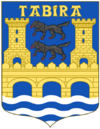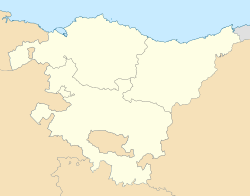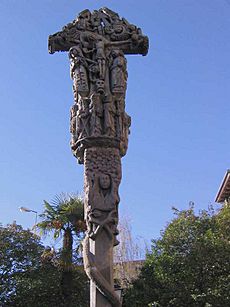Durango, Spain facts for kids
Quick facts for kids
Durango
|
||
|---|---|---|
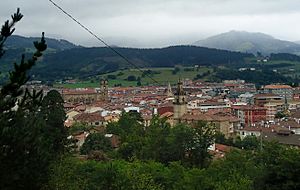
Partial view of Durango
|
||
|
||
| Country | Spain | |
| Autonomous community | Basque Country | |
| Province | Biscay | |
| Comarca | Durangaldea | |
| Founded | In the early 13th century | |
| Area | ||
| • Total | 10.79 km2 (4.17 sq mi) | |
| Elevation | 119 m (390 ft) | |
| Population
(2018)
|
||
| • Total | 29,636 | |
| • Density | 2,746.6/km2 (7,114/sq mi) | |
| Demonym(s) | Durangar | |
| Time zone | UTC+1 (CET) | |
| • Summer (DST) | UTC+2 (CEST) | |
| Postal code |
48200
|
|
Durango is a lively town and municipality in the Biscay province of Spain. It's part of the Basque Country. Durango is the main town in an area called Durangaldea. It's one of the biggest towns in Biscay, especially known for its busy economy and many people.
About 29,715 people lived in Durango in 2023. Three rivers flow through the town, which is even shown on its town symbol! The main river is the Ibaizabal. It runs through a wide valley. To the south, you can see the Urkiola mountain range and its natural park. The tallest mountain nearby is Anboto, standing at 1,331 meters (about 4,367 feet). Inside the town, two other mountains stand out: Pagasarri (838 meters) and Mugarra (453 meters).
Contents
What's in a Name? The Etymology of Durango
People have different ideas about where the name Durango comes from. One idea is that it comes from "Duranco," a name possibly used long ago. Others think it might be from "Urazango" or "Padurango."
The Royal Basque Academy of the Language suggests that "Durango" might come from the Latin name "Turanicus." This could have been a Roman farm or settlement, like many others in the Basque Country. When the town's special laws (called fueros) were confirmed, it was called "Tavira de Durango." "Tavira" was probably the first name of the settlement, and "Durango" was the name of the area around it. Until the 16th century, the town was known as Uribarri de Durango, which means "New town" in Basque.
A Look Back: The History of Durango
We don't know the exact year Durango was founded. It was first part of the Kingdom of Navarre. Documents from 1179 show it was involved in land arguments between two kings: Alfonso VIII of Castile and Sancho VI of Navarre. To protect his land, King Sancho VI built other fortified towns like San Sebastián.
Between 1199 and 1201, King Alfonso VIII of Castile took control of Durango and its surrounding areas. Durango then became part of the Crown of Castile. However, the Castilian king allowed the town to keep its old laws and traditions.
Conflicts and Royal Visits
In the 15th century, Durango saw some conflicts. Different families, like the Ibarguen and Zaldibar families, were involved in what was called the War of the Bands. During this time, strong tower houses were built by these families.
Important kings and queens visited Durango. Henry III (in 1393) and Henry IV (in 1457) were welcomed here. Queen Isabel of Castile, also known as "The Catholic," visited in 1483. She promised to support Durango and the region if they supported her. She also swore to uphold their special laws, called fueros, and offered good trade deals. Records show that both monarchs stayed in the Lariz Tower.
Challenges and Growth
Durango faced tough times in the 16th century. In 1517, a terrible plague caused many deaths. A few years later, in 1544, heavy floods covered much of the town. Then, in 1554, a big fire burned down almost all the wooden buildings. Another plague hit in 1597. Despite these challenges, the Town Hall was built in the 16th century.
The name Durango became famous! Francisco de Ibarra, a Spanish explorer, used the name to found new places in America. For example, there's a state in Mexico called Durango, and its main city is also named Durango.
In the 17th century, Durango suffered because of many wars the Crown of Castile fought against France. The town lost many people and a lot of money. After battles and a cholera outbreak, the town was almost ruined.
Things started to improve at the end of the 19th century. In 1882, the railway line from Bilbao to Durango opened. Even though it was expensive to build, Durango began to grow and prosper in the early 20th century.
Spanish Civil War
During the Spanish Civil War, Durango faced a very difficult period. On March 31, 1937, planes from other countries bombed Durango. Durango was a town of 10,000 people and an important travel hub. More than 500 people were killed in the bombing and in the days that followed. On April 28, 1937, Durango was taken over by a different group without much fighting.
Main Sights: Places to See in Durango
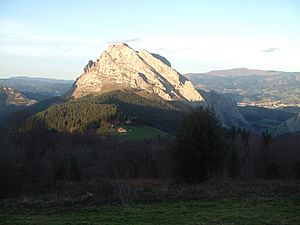
- The Kurutziaga Cross (found in the Kurutzesantu Museum). This cross was built between the late 15th and early 16th centuries. It tells a story and has a Gothic style with influences from Flanders and Germany.
- Baroque Santa Ana's Arch. This arch was designed in the 18th century by a local architect, Juan de Herdoiza. It was part of the old town walls, which are now gone. The arch was built to be a grand entrance to the town, where kings would pass when they visited.
- Mikeldi idol. This is a very old statue from before Roman times. It shows an animal with four legs.
- Lariz Tower. This is an old city palace built around the end of the 15th century. It was updated in 2009 and now serves as the town's Tourist Information Office. People believe that Queen Isabella the Catholic stayed here when she visited Durango to agree to the local laws. The building has beautiful old decorations, like large windows and rounded arches.
Economy: How Durango Makes a Living
Durango's economy mostly focuses on making things. It's been known for a long time for building machine tools and working with metallurgy (metals). Services like healthcare, education, and research and development are also growing in the area.
For many years, Durango was home to Euskal Telebista, a public television company. It broadcasts in Basque and Spanish. It even has a channel that reaches people around the world! ETB has since moved its main office to Bilbao.
Language: What People Speak
In Durango, people speak Spanish. They also speak a special local version of Basque called Biscayan Basque (bizkaiera).
Transportation: Getting Around Durango
Bus
There's a BizkaiBus service to Bilbao every half an hour. One route uses the AP-8 motorway and takes about 30 minutes. Another route is slower, stopping in all towns, and takes about 50 minutes. There's also a bus once an hour to Eibar, a nearby town similar in size to Durango.
Buses also go to many coastal villages, like Ondarroa and Lekeitio. You can also find direct buses to Vitoria-Gasteiz and Donostia-San Sebastián.
Train
The trains (from the EuskoTren company) are narrow gauge, meaning the tracks are narrower than usual. For a long time, the railway cut through Durango, and seven level crossings caused traffic jams.
After seven years of building, new train services started using a 4-kilometer (2.5-mile) tunnel under Durango on December 17, 2012. This big project cost €232 million and was paid for by the Basque government. It included building an underground station in the town center. This allowed the old railway line, which went right through the town, to be closed.
The tunnel opened exactly 130 years after the first train from Bilbao arrived in Durango. It's a key part of making the Bilbao – San Sebastian line better. This project also includes adding a second track for 15 kilometers, getting rid of 27 level crossings, and building new stations in Euba, Durango, and Traña.
Trains go to Bilbao-Atxuri station and Donostia. You can also get to Gernika and Bermeo by changing trains at Amorebieta.
Sister Cities: Friends Around the World
Durango has two sister cities, which means they have special friendly relationships:
Notable People
- Juan de Yciar, a calligrapher and mathematician
- Martín Ruiz de Gamboa, a Spanish governor in Chile
- José María Ampuero Jáuregui, a politician
- Benita Uribarrena Bollaín, a member of the French Resistance
See also
 In Spanish: Durango (España) para niños
In Spanish: Durango (España) para niños


